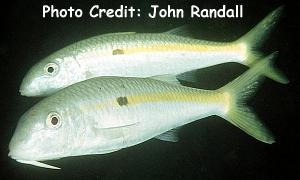
By Bob Goemans


Not Reef Tank Suitable
Likely Fish-Only Tank Suitable
These fish belong in the Order Perciformes and Suborder Percoidei as members of the Family Mullidae (Goatfishes), which consists of 6 genera, containing at least 35 described species. Most hail from the Indo-Pacific or the Eastern Pacific region, however, there are some found in the Atlantic Ocean, in both tropical and semi-temperate waters.
In the wild, these fish mostly live in areas containing soft substrates, and because of that, favor shallow protected bays and lagoons where sand, rubble, and/or mud collects. Most species are difficult to identify using morphological features alone, however, color variations do help, especially for those who are not trained scientists. Their diet consists mainly of benthic invertebrate such as shrimp, worms, small brittle stars, and crabs. They generally have elongated bodies with large scales, a small mouth, and have two strong barbels/whiskers on their chin, which are used for digging and sensing prey in various substrates and crevices. In fact, each barbell can individually be moved, helping to quickly located buried prey in either direction. Their anterior and posterior dorsal fins are set wide apart, with the caudal fin deeply forked.
Since their diet mainly consists of benthic invertebrates, they often overturn small pieces of rubble to expose concealed prey. In aquaria this sometimes causes stress, both to its inhabitants and the aquarist when the target is small corals and clams! Nevertheless, they are generally peaceful, yet some will also feed upon small fish. Most younger/smaller specimens make good sand stirrers. In aquariums they should be offered a meaty diet consisting of various types of chopped/graded fresh and frozen marine fish and crustacean flesh, and if possible, live grass/ghost shrimp.
Even though there are many different species entering the trade, past experience has shown only a few species in two genera make suitable specimens for hobbyist aquariums, i.e., Parupeneus and Pseudupeneus. Therefore, the real useable choices are quite limited in the present aquarium trade. And as to other species than those discussed here, care must be taken to identify those newcomers before placing them in your aquaria since most can get far too large for anything but a large aquarium, i.e., over 125 gallons. Besides, many can or will become fish eaters as they grow to maturity, and that could lead to a diminished head count in your aquarium! So be careful when choosing a goatfish for your aquarium and do the necessary research before putting it your aquarium!